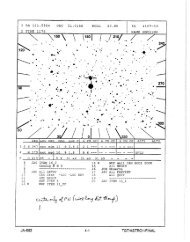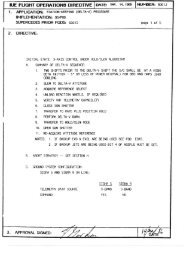The FUSE Archival Data Handbook - MAST - STScI
The FUSE Archival Data Handbook - MAST - STScI
The FUSE Archival Data Handbook - MAST - STScI
You also want an ePaper? Increase the reach of your titles
YUMPU automatically turns print PDFs into web optimized ePapers that Google loves.
Chapter 5<br />
Ancillary Files<br />
This section describes additional data files available from the <strong>FUSE</strong> archive that can be used<br />
to support the analysis and understanding of <strong>FUSE</strong> data. Some of these data files were used<br />
by Cal<strong>FUSE</strong> to produce the calibrated data products, and others contain information which<br />
can be used to verify the pointing, performance, or status of the satellite or instrument during<br />
data acquisition.<br />
This chapter contains information potentially useful to the “Advanced” and “Intermediate”<br />
users. However its contents are not of immediate relevance to the “Casual” user. <strong>The</strong> file<br />
naming convention used throughout this chapter has been described in Section 4.1.2.<br />
5.1 FES Image Files (*fesfraw.fit, *fesfcal.fit)<br />
Two nearly identical Fine Error Sensor (FES) cameras were available on <strong>FUSE</strong>. FES A was<br />
prime for most of the mission, and observed the LiF1A FPA. FES B became prime on 12 July<br />
2005 and was used for the remainder of the mission. It observed the LiF2A FPA. Because the<br />
two cameras are on opposite sides of the instrument, the astronomical orientation in the images<br />
will appear flipped with respect to each other. Referring to the guide star plots for a given<br />
observation will provide confirmation of the expected astronomical orientation and star field<br />
expected for a given target (see Section 5.6 below).<br />
An image from the active FES camera was routinely acquired at the end of an observation<br />
to allow verification of the pointing of the spacecraft. Depending on the phase 2 observing<br />
proposal instructions provided by the user, this FES image would be obtained either with the<br />
target in the observing aperture or at the reference point (55.18 ′′ from the HIRS aperture,<br />
displaced towards the center of the FES field of view; see Fig. 2.2). By convention, this exposure<br />
always has exposure ID 701, which is used to distinguish this image from acquisition images.<br />
Other FES images were obtained throughout each observation during the initial guide star<br />
acquisition and subsequent reacquisitions (usually after the target had been occulted). <strong>The</strong>se<br />
images are also stored and are available to the observer, although the target may be offset or<br />
even absent in these images (e.g. if the target had drifted during occultation, etc.). <strong>The</strong>se<br />
42




